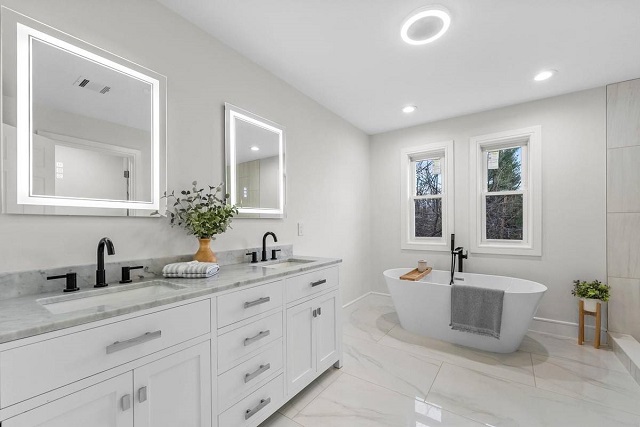DIY interior painting tips

Table of Contents
Preparation is Key
To achieve a successful painting job, thorough preparation is essential. Before you even think about dipping your brush into a can of paint, take the time to properly plan and prepare your painting project. Begin by assessing the condition of your walls and determining any repairs or cleaning that may be necessary. Addressing these issues before you begin painting will ensure a smooth and flawless finish.
Next, gather all the necessary tools and materials needed for the job. This includes high-quality paint, brushes, rollers, drop cloths, painter’s tape, and any other equipment required for the specific project. Having everything you need at your disposal before you start will help streamline the painting process and prevent interruptions. A well-prepared work area will not only make your job easier but will also lead to professional-looking results that you can be proud of.
Choosing the Right Paint Color
When selecting the right paint color for your walls, it is imperative to consider the overall aesthetic you wish to achieve in the space. Take into account the room’s natural lighting, size, and purpose to guide your decision-making process. Warmer tones like beige and soft yellows can create a cozy atmosphere, while cooler shades such as blues and grays can promote a sense of tranquility and spaciousness.
Furthermore, it is essential to test paint swatches on the walls before committing to a color. The lighting in your home can affect how a color appears, so observing the swatches at different times of the day can help you determine if the hue complements your furniture and decor. Remember to trust your instincts and choose a color that resonates with you and enhances the ambiance of the room.
Selecting the Proper Tools and Equipment
Selecting the proper tools and equipment is essential for achieving a professional finish when painting your walls. Invest in high-quality paintbrushes and rollers to ensure smooth application and even coverage. Look for brushes with tightly packed bristles and rollers that are designed for the type of paint you will be using. Additionally, consider the size of the rollers and brushes based on the surface area you will be painting to avoid fatigue and achieve efficiency.
Having the right tools also includes ensuring you have the necessary equipment for your specific painting project. This may include drop cloths to protect your floors and furniture, paint trays for easy access to paint, and extension poles for reaching high walls or ceilings. It’s important to have all your tools ready and organized before starting your painting project to streamline the process and prevent interruptions. By investing in the proper tools and equipment, you can set yourself up for success and achieve professional results in your painting endeavors.
Protecting Your Furniture and Floors
When embarking on a painting project, it is essential to safeguard your furniture and floors from accidental spills and splatters. Begin by clearing the room of any movable items such as chairs, tables, and decorative objects. Once the space is decluttered, cover larger furniture pieces with plastic drop cloths to shield them from paint drips. For hardwood or tile floors, lay down rosin paper or a thick canvas drop cloth to prevent any unwanted stains or damage from paint spills. Taking these precautions will not only protect your belongings but also make the cleanup process much easier once the project is complete.
In addition to covering furniture and floors, it is also crucial to take extra care around baseboards and trim work. Use painter’s tape to mask off these areas and create clean, crisp lines along the edges. Be sure to press the tape firmly in place to create a tight seal and prevent any paint bleed-through. By investing time in properly protecting your furniture, floors, and trim work, you can ensure a polished and professional-looking paint job that will enhance the overall aesthetic of your space.
Properly Prepping Your Walls
Properly prepping your walls before painting is essential to achieving a flawless finish. Begin by thoroughly inspecting the surface for any imperfections such as cracks, holes, or peeling paint. Fill in any gaps using a high-quality spackling compound and sand the area smooth once it has dried completely. This initial step sets the foundation for a professional-looking paint job.
After repairing any surface flaws, it is crucial to clean the walls to remove any dirt, grease, or dust that could affect the adhesion of the paint. Use a mild detergent solution and a sponge to wash the walls gently, ensuring all residue is removed. Allow the walls to dry completely before proceeding with any further prep work. Remember, the key to a successful painting project lies in the meticulous attention to detail during the prepping stage.
Using Painter’s Tape Effectively
When it comes to achieving clean lines and professional-looking results in your painting project, using painter’s tape effectively is essential. Proper application and removal of painter’s tape can make a significant difference in the overall outcome of your paint job.
To start, ensure that the surface you plan to tape is clean and dry before applying the tape. Press down firmly on the edges of the tape to create a tight seal and prevent any paint bleed. When removing the tape, do so carefully and at a 45-degree angle to ensure crisp, clean lines. Remember, painter’s tape is a valuable tool in your painting arsenal, so take the time to utilize it effectively for a flawless finish.
Applying Primer for a Smooth Finish
When it comes to achieving a flawless paint job, applying primer is a crucial step that should not be overlooked. Primer serves as a base coat that helps the paint adhere better to the surface, improves color consistency, and provides a smooth finish. Before you start priming, ensure that the surface is clean, dry, and properly prepped to allow the primer to bond effectively.
Choose a high-quality primer that is suitable for the surface you are painting, whether it be drywall, wood, or metal. Apply the primer evenly using a roller or brush, making sure to cover the entire surface. Allow the primer to dry completely before applying the paint to ensure a seamless and professional-looking finish. Remember, the key to a smooth paint finish lies in the quality and application of the primer.
Mastering Cutting In Techniques
When it comes to achieving clean lines and sharp edges while painting, mastering cutting-in techniques is essential. This skill involves using a steady hand and precise brushwork to carefully outline areas that cannot be easily reached with a roller.
To effectively cut in, start by loading your brush with an appropriate amount of paint and removing any excess. Then, use the tip of the brush to create a straight edge along corners, ceilings, and trim. Take your time and work slowly to ensure a smooth and even line. Remember, practice makes perfect when it comes to mastering this technique, so don’t be discouraged if it takes some time to perfect your skills.
Achieving a Consistent Paint Finish

To achieve a consistent paint finish, it is crucial to ensure that your paint is properly mixed before application. Inconsistencies in the paint can result in variations in color and finish, leading to an uneven appearance on your walls. Take the time to thoroughly stir the paint to blend all the pigments evenly, ensuring a uniform color throughout the painting process.
Additionally, applying the paint with consistent pressure and strokes is essential for a smooth and even finish. Avoid applying too much pressure, as this can cause the paint to clump or streak on the wall. Instead, use steady and even strokes to distribute the paint evenly and achieve a professional look. Remember to overlap each stroke slightly to blend the paint seamlessly for a cohesive and consistent finish.
Knowing When to Use Multiple Coats
Knowing when to use multiple coats of paint is essential for achieving a professional and flawless finish on your walls. Generally, the decision to apply more than one coat depends on various factors such as the type and color of the paint, the condition of the surface, and the desired final look.
In most cases, it is recommended to apply multiple coats of paint to achieve full coverage and even color distribution. Darker or bold colors often require more coats to prevent streaks or patches from showing through, while lighter shades may only need one or two coats. Additionally, if the surface has imperfections or previous paint colors peeking through, using multiple coats can help to conceal these flaws and create a smooth, uniform appearance. Remember, patience is key when it comes to adding multiple layers of paint – rushing the process can result in a subpar finish that will require additional touch-ups in the future.
Dealing with Common Painting Mistakes
One common painting mistake that inexperienced individuals often make is failing to properly prepare the surface before beginning to paint. This can lead to issues such as poor adhesion, uneven coverage, and paint peeling or chipping prematurely. To avoid this mistake, be sure to thoroughly clean the surface, sand down any rough areas, fill in any holes or imperfections, and prime as needed before applying the paint.
Another frequent mistake is rushing the painting process and not allowing adequate drying time between coats. This can result in an uneven finish, color bleed-through, and even paint lifting off the surface. It is essential to follow the manufacturer’s instructions regarding drying times between coats to ensure a smooth and flawless paint job. Additionally, resist the temptation to overload the brush or roller with paint, as this can lead to drips, streaks, and an unsightly finish.
Cleaning Up After Painting
After the final brushstroke is applied and your walls are looking fresh with a new coat of paint, it’s crucial to properly clean up your workspace. Begin by carefully removing any painter’s tape from the edges of the walls, taking care to peel it gently to avoid damaging the newly painted surface. Be meticulous in tidying up any paint cans, brushes, and other supplies, making sure to seal them properly to prevent drying out. Additionally, wipe down any spills or drips on floors or furniture promptly with a damp cloth to prevent them from drying and becoming difficult to remove later.
Once your workspace is organized and all supplies are put away, thoroughly clean your brushes, rollers, trays, and any other painting tools with warm, soapy water. Ensure all leftover paint is properly sealed and stored according to manufacturer’s instructions to maintain its quality for future touch-ups or projects. Finally, give your painted walls ample time to dry and cure completely before moving furniture back into place or hanging decorations. This attention to detail in cleaning up after painting will not only maintain the integrity of your work but also ensure a smooth finish that stands the test of time.
Drying and Curing Your Paint Properly
After you have finished painting your walls, it is crucial to allow the paint to dry and cure properly. Ensure the room is well-ventilated to aid in the drying process. Avoid touching or leaning anything against the painted surfaces to prevent smudges or imperfections. It is recommended to wait at least 24 hours before reattaching hardware or placing furniture back in the room to allow the paint to fully dry and cure.
The drying time may vary depending on factors such as humidity levels and temperature, so it is essential to follow the manufacturer’s guidelines for the specific paint you have used. Curing, on the other hand, refers to the time it takes for the paint to reach its maximum hardness and durability. This process can take up to 30 days, during which you should be cautious not to damage the painted surfaces. By allowing the paint to properly dry and cure, you will ensure a long-lasting and professional finish to your painting project.
Adding Finishing Touches
After completing the painting process, attention to detail in adding finishing touches can truly elevate the overall look of the room. One essential step is to carefully inspect the entire painted surface for any missed spots or areas that may require touch-ups. Doing so will help ensure a seamless and polished final result. Additionally, consider adding a protective top coat or sealant to safeguard the painted walls against wear and tear, as well as to enhance the durability of the finish.
When focusing on adding finishing touches, don’t overlook the importance of cleaning up any splatters or drips that may have occurred during the painting process. Using a damp cloth or sponge, gently remove any stray paint marks on trim, baseboards, or floors to achieve a pristine appearance. Finally, take the time to remove any painter’s tape carefully and inspect the edges for crisp lines. These small but crucial steps can make a significant difference in the overall professional look of your freshly painted room.
Maintaining Your Painted Walls
To ensure the longevity and vibrancy of your painted walls, regular maintenance is essential. One key aspect of maintaining painted walls is to promptly address any marks, scuffs, or stains that may appear. By addressing these issues as soon as they arise, you can prevent them from becoming more difficult to remove over time. It is recommended to have a gentle cleaning solution on hand for light touch-ups and a more robust cleaner for tougher stains, taking care to test in an inconspicuous area first to ensure compatibility with your paint.
In addition to addressing blemishes promptly, it is important to periodically assess the condition of your painted walls. This includes checking for any signs of peeling, cracking, or fading. Should any of these issues be detected, it is advisable to take action promptly to prevent further deterioration. By proactively maintaining your painted walls, you can preserve their beauty and extend the life of your paint job.






